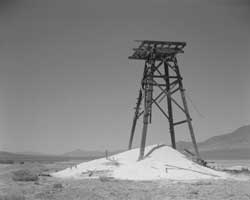Steven Dixon: Spare

Steven Dixon: Desert Structure No. 1, 2006
Digital print on Japanese paper mounted on panel
The Art Gallery of Alberta, formerly the Edmonton Art Gallery, is featuring an exhibition of prints by Steven Dixon called Spare:
Steven Dixon’s large-scale works record the consequences of human activity, documenting the shift from a natural resource based economy to one focused largely on information and technology. This change has left in its wake a legacy of disused industrial structures: abandoned mines, mills and factories and related town-sites. Dixon has been exploring these ruins with a camera, photographing the traces of activity left behind by those employed in these industries, and tracing the detritus of past activity. This exhibition, Spare, features three new works, comprised of digital photographs printed on Japanese paper and mounted on panels.
Steven has worked in moderate sized photogravures for many years, so I was curious about his large scale digital work. In emails, I asked Steven about his new direction. He’s allowed me to quote his responses here.
I have gone digital with the latest work because of the scale. The largest piece in the show is 240 x 300 cm and I am making the files by scanning internegs in order to get the files large enough to work with. With the limitations of my scanner I needed to take that extra step. The file for that image was about 1.2 gigabytes. The smaller images are scanned directly from 4×5 negs.
At this point in time I don’t know anybody who is straight digital…..I just went to a lecture by Ed Burtynski and he has tested it but gone back to film because it is easier to deal with in the field. He said it is much easier and quicker to use a Polaroid back to check results than to lug around a laptop along with all the other equipment. The lens quality of digital cameras may never approach the quality of conventional lenses (at any reasonable price anyway).
What is an interneg?, I asked.
The interneg is just an enlargement on film from the original negative. In my case I guess it really isn’t an interneg because it is positive. What I did was make an enlarged positive transparency so I could scan it. I went from a 4×5 negative to an 8×10 positive, then cut that into 4 – 4x5s and scanned them individually and rebuilt the image in photoshop. That way I could get a larger file than just going from the 4×5.
Thanks for this information, Steven, and congratulations on your show, I wish I could be there!
Readers, if you are in Edmonton, do see Steven’s excellent work. The opening reception is on Friday, March 10th at 7 pm and the exhibition continues until June 10th, 2006.
Long-time readers might recall my friend Steven’s name – he is one of the artists in the Traces exhibition that Steven, Bonnie Jordan and I presented in Pohjanmaan Museum in Vaasa, Finland in 2002. We even travelled together to Finland and Estonia. I’ve also mentioned his show at the Lando Gallery, where you can see some of his earlier photogravure work.
March 8, 2006 in Art Exhibitions, Digital printmaking, Other artists, Photography by Marja-Leena
I love this image, thank you, and I was very pleased to be able to see more of Steven Dixon’s work on the Lando Gallery site. There is something so emotionally evocative about industrial structures when all is still in the picture, and no folks around either. I am very attracted to the photographs of Bernd and Hilla Becher. In many ways I think of them as another era of standing stones.
I do wish that I could see the Steven Dixon Spare pieces full size – that must be something else!
You always find the best sites, I had never even heard of Steven Dixon but he’s really wonderful. Thanks!
Glad you like Steven’s work, Omega and Elise! I was so pleased he agreed to exhibit with Bonnie and me in Finland, with some of those works that are shown on the Lando Gallery site. Did you check out the Traces link about it?